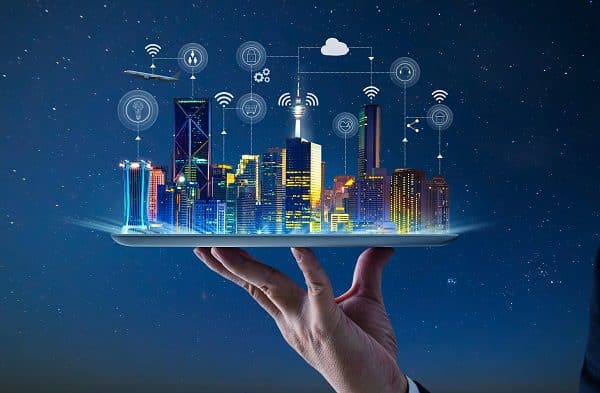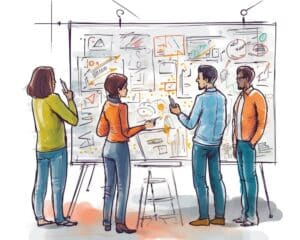[Interview]
The smart city and the low-tech city are two different approaches to meeting the challenges facing cities today. Improving citizens' quality of life, tackling the consequences of climate change, preserving the environment, saving energy... Cities can turn to smart city solutions that rely heavily on digital technologies. Or they can opt for a low-tech approach that favours simple technical solutions. And why not both?

Smart city or low-tech city... the two concepts are often contrasted by their respective supporters and detractors. So which solutions should cities choose to improve their management and performance? How can they provide the population with the level of service they expect while keeping costs under control? How can they make an effective contribution, at their own level, to the fight against climate change?
Marie Baudry, an expert in smart territory strategy and digital project management, answers ORSYS' questions.
Smart city and low-tech city: what are we talking about?
The smart city and the low-tech city are two different approaches to meeting the challenges of today's cities.
When we think of smart cities, we often think of high-tech technological solutions. And with good reason, because the term was coined in the 90s by IBM. The idea? To meet the growing needs of cities in terms of information systems, IT infrastructures and the digitalisation of citizen services. It then gradually made its way into political discourse, until it became a buzzword. a real brand image for towns.
Among the pioneering cities, Toronto has taken up the approach from a digital city perspective. Barcelona was also quick to experiment with energy management solutions. It would seem that smart city approaches are better suited to the complex needs of large metropolises. But in reality, there are no no consensus definition of the smart city. First and foremost a common presupposition: data. Then, what best characterises the 'intelligent' city is the idea of adapting solutions to the priority issues of an area and using technology where it is useful. With discernment, then.
Smart city is one of the terms used to describe the city of the future. More recently, in connection with climate issues and the notion of resilienceThe concept of the low-tech city has also gradually found its way into local policies. Low-tech does not have an established definition, but it can be understood as a set of simple and inexpensive technological solutions based on practicality. It is often associated with the idea of sobriety. A concept that seems better suited to small communities or neighbourhoods, where needs are less complex.
Should the two approaches be opposed?
Today, towns and cities embarking on a smart city approach start by take stock of the situation. They then realise that they are already carrying out actions that can be included under this heading. In public lighting, for example. But also, and above all, because the smart city is not just about high-tech solutions. It is also based on common sense. In this respect, it is not directly opposed to the low-tech approach.
Sobriety, another term often used in the concept of the low-tech city, is not incompatible with the smart city. On the contrary, real-time data collection and management is one of the solutions currently being used to rationalising public services (household waste collection, etc.) and optimising energy consumption. However, the networks and equipment used can be very energy-hungry. Connected" regions will therefore have to address the issue of digital sobriety.
Smart city, low-tech... When it comes down to it, for many people, using one or other of these terms is just a question of "what's in it for me? territorial marketing. The choice of a high-tech or low-tech solution depends just as much on the financial resources of the local authorities concerned. Going further, we could say that a region's interests lie in adding up all the intelligence deployedThese are the kinds of technologies, both high-tech and non-high-tech, that will enable us to become more virtuous and more resilient.
What are the challenges facing the city of tomorrow?
The challenges of tomorrow's city are already present today. These include
- Adapting to the consequences of climate change
- Reducing our carbon footprint
- Better management of resources (water, energy, etc.)
- Preserving the environment and biodiversity
- Meeting the new needs of the population: mobility...
In addition, local authorities are facing a reduction in their grants. With budgets under pressure, they are looking for innovation, optimisation and savings.
How can smart city or low-tech solutions help?
Initially, the most emblematic smart city solutions deployed in France revolved around night-time lighting. This is one of the most energy-intensive areas of expenditure, and therefore costly for local authorities. However, modernising the public lighting network provides a return on investment in just a few years.
For example, installing low-energy light bulbs will savesave 50 to 60 % of energy.
Even if this measure is more common sense than a technological advance, it can be described as "intelligent", which already makes it a smart city approach. The next step is to control the intensity of the lighting and switch it on on demand or by section, depending on the number of people passing by, which will also lead to substantial savings.
Local authorities are also looking for new solutions for implementing the energy transition. From an economic point of view, the idea of cheap and abundant energy is a thing of the past. The time has come to optimise energy production and consumption. And from an ecological point of view, local authorities are also aiming to reduce their environmental footprint. carbon impact by reducing greenhouse gas emissions.
As a result, some regions have set up smart electricity grids or smart grids.
What does it involve?
Thanks to a data-driven managementThe idea is to distribute energy according to demand. More specifically, it involves identifying uses to improve energy performance and make savings. For example, making better use of air conditioning, offloading certain machines when consumption peaks, etc. connected meter is one of the first building blocks of these intelligent networks.
Smart grids are particularly well suited to island contexts, where a large proportion of energy is imported (from 40 % in Corsica to 80 % in Guadeloupe). In these areas renewable energies (wind, solar, geothermal, hydro, etc.) are the key to achieve energy independence targetsSome of them, however, have the major drawback of being intermittent (wind and solar power). But some have the major drawback of being intermittent (wind and solar power). With the networking of energy production micropoles, smart grids make it possible to reduce the energy consumption of the grid. smoothing of production and make the integration of these alternative energies credible.
Are smart city solutions right for small towns?
Absolutely. Saint-Sulpice-la-Forêt is a good example. This rural commune of 1,500 inhabitants has equipped its communal buildings with connected sensors to save energy. By monitoring consumption in real time water, electricity, gas, as well as a series of indicators (indoor temperature, luminosity, air quality, etc.), it has been able to produce a detailed report. energy savings of 20 % in two years. The result was so satisfying that Shanghai, China's most populous city, sent a delegation to the site!
A surprising example of a smart city solution?
Yes, and then some! Local authorities are in the process of innovating. Some smart city solutions that have been tested are eventually abandoned. When it comes to parking, for example, sometimes the best ideas are the simplest.
The first example concerns a smart parking system. The idea is to use mobile applications to show motorists in real time which spaces are available in the city centre. What a great idea! Looking for a parking space in these densely populated areas is often time-consuming and generates extra traffic, even though some parking spaces are available. Thanks to sensors installed on the ground or cameras, the geolocation of these spaces is supposed to make parking easier.
A good idea... on the face of it. Firstly, because the lifetime of a free space is 30 seconds. Secondly, the equipment (sensors, cameras, etc.) has to be adapted. a cost that must be financed... if possible other than through taxation. Several projects have been abandoned or limited to car parks with a limited number of spaces.
It could have been simpler and more "intelligent". Parking meters can already be used to obtain statistics on the occupancy of parking spaces. There's no need to add sensors or cameras. Once again use technology wisely. This is not exclusive to low-tech.
The second example is free parking. Some towns have opted for this solution. Firstly, because it's expensive to renew a fleet of parking meters. Secondly, because it involves paying staff or a service provider to issue fines and manage complaints. Finally, this simple solution is also an "intelligent" one. As such, it deserves to be called a smart city.
Smart cities, smart grids, smart parking... so it's fair to say that 'smart' solutions cover a huge range of areas?
Indeed, this is the case. Smart city solutions serve public spaces and the public at large (residents, tourists, businesses, etc.). They can be used to simulate living conditions in a future district, adapt housing for the elderly or disabled, adjust transport and mobility policies, optimise buildings, and so on.
The rise of new technologies has also led to the development of the notion of smart building. By making the building a place where data is collected and analysed, it is possible to optimise its management and to offer new services to its users. What's more, in a R2S building for "ready to serviceNew services are inexpensive if the technical infrastructure is designed in advance. We therefore need to include a 'smart' package in the specifications (IP network, interoperable data hosted in the cloud, shared infrastructure and security layers, etc.).
Similarly, the data from connected objects and home automation enable buildings to be managed more efficiently. This is made possible by their integration into the digital model via BIM (building information modeling) and its application with BIM GEM (management, operation and maintenance).
What are the pitfalls to avoid?
In Europe, there are a number of obstacles to the development of smart city initiatives. Generally speaking, the presence of sensors frightens citizens. It requires a lot of teaching Explain the objective and reassure people that the data collected will be anonymous. This is the approach proposed by the city of Angers. In Asia, on the other hand, there are few such fears. For example, facial recognition is well accepted there because it meets security objectives. The French municipalities that have ventured into this area, such as Nice, have seen that we are not ready for it culturally and, above all, legally.
Another difficulty is the data processing. While installing the equipment (sensors, antennas, etc.) is relatively easy, making the data intelligible is more complex. This involves transforming big data into smart data in particular to provide useful information for decision-making by elected representatives and to enable them to act quickly on certain issues. But this data processing comes at a cost. It is questionable whether it would be acceptable to fund it from the local authority budget, in other words through taxation.
In France, the principle is still that of open data (raw data accessible to all). Elsewhere, cities such as Copenhagen are opting to charge for access to their "cleaned" data, which enables them to finance the collection and processing of raw data.
Finally, the risk of cyber attacks is not out of the question.
What is the profile of the people who come to learn about the challenges of the smart city?
The participants have varied profiles. They come from both the public and private sectors. They are interested in the subject in the context of a taking up a post or are looking for a exchange dynamics with other participants.
Very often, they come to the course with a somewhat caricatured idea of the smart city. They leave with a broader vision. Overall, they are pleased to see that the smart city touches on a wide range of areas, that there is no single model and that they have discovered many tools that will enable them to go further.





